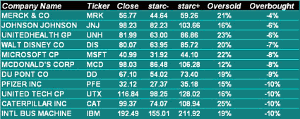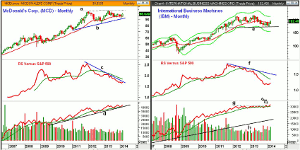The Dow Industrials has underperformed the S&P 500 by almost 7% over the past year but Moneyshow’s Tom Aspray has identified three Dow stocks using his monthly scan that may end up being winners in 2014.
Tuesday’s new closing high in the S&P 500 completes the 16-day trading range and gives upside targets in the 1924-1930 area. The market was led by the Nasdaq Composite and Nasdaq 1000, which were up 1.64% and 1.74% respectively. One of the best groups, the SPDR S&P Regional Banking ETF (KRE), which was featured in yesterday’s column gained 1.86%.
The Dow Industrials closed at 16,532, which is just below the closing high of 16,576 from December 31. The daily relative performance analysis on the SPDR Dow Industrials (DIA) is positive for the first time since late 2013. This indicates that it has been stronger than the S&P 500 recently.
The DIA closed 7.5% below its monthly starc+ band last month and therefore still has significant upside potential. With the market at all-time highs, the monthly starc band scan can often give one additional insight. Oftentimes those stocks that are overbought (closest to their starc+ band) can alert one to stocks that are in the process of making important turns, as well as those stocks that are becoming more vulnerable.
Two drug stocks, Merck & Co. (MRK) and Johnson and Johnson (JNJ) top the most overbought list this month as they are the Dow stocks, which are closest to their monthly starc+ bands.
The monthly chart analysis of each of the Dow stocks reveals one that may be losing upside momentum, as well as another that has recently overcome decade-long resistance. Two other Dow stocks appear to be completing monthly continuation patterns and could be market leaders later in the year. These are the Dow stocks you should be watching.
Chart Analysis: The monthly chart of Walt Disney Co. (DIS) shows that it formed a doji last month, which is a sign of indecision as it closed the month where it opened.
- The quarterly pivot is at $77.86 and an April close below $77.28 would trigger a low close doji sell signal.
- The short-term monthly uptrend, line a, is now at $73.06 with the rising 20-week EMA at $63.92.
- The monthly relative performance did confirm the recent highs but has now turned lower.
- The weekly RS analysis (not shown) is positive while the daily is not.
- The monthly OBV is holding well above its WMA and the weekly OBV has turned up from its WMA.
- A close above the short-term resistance at $82.30 will signal a test of the all-time highs at $83.65.
- The monthly projected pivot resistance is at $86.70.
Microsoft Corp. (MSFT) had a good 1st quarter as it gained over 11%. The monthly chart shows that the resistance going back to 2011, line c, was decisively overcome in March.
- The 13-year trading range was $19 wide so the upside targets are in the $50-53 area.
- MSFT made its all-time high of $43.82 in December of 1999, which is just below its monthly starc+ band at $44.10.
- The five-year downtrend in the relative performance has been broken as it has been above its WMA for the past five months.
- The weekly RS line completed its bottom two weeks ago signaling that MSFT was now a market leader.
- The monthly OBV overcame major resistance, line e, in April of 2013.
- Since then, the OBV has held above its rising WMA though it was tested last September.
- The weekly OBV (not shown) has continued make new highs since last October.
- There is first good support now in the $40-$40.40 area with the quarterly pivot at $38.95.
NEXT PAGE: 2 More Overbought Dow Stocks to Watch
|pagebreak|Though McDonald's Corp (MCD) was a star performer in 2011 when it gained 34%, it has disappointed investors over the past two years. It was down 9.22% in 2012 and up just 13.54% in 2013 as it lagged the S&P 500.
- The monthly chart shows that a flag formation has formed since the January 2012 highs, lines a and b.
- MCD has been testing its 20-month EMA over the past six months and is currently at $94.84.
- On a close above $103.70, the flag formation has upside targets in the $123-$128 area.
- The relative performance made a new high in early 2012 and dropped below it two months later.
- The monthly RS line is still below its downtrend, line c, and its declining WMA.
- The weekly and daily RS analysis (not shown) is closer to bottoming.
- The monthly pivot is at $97.03 with the quarterly pivot at $96.18.
- There is even stronger support in the $94-$95 area.
International Business Machines (IBM) has also lagged the overall market since 2011 when it was up 27.27%. It was up 5.97% in 2012 but was down 0.15% in 2013.
- The monthly chart shows that the important support, line e, in the $171 area was tested in early February.
- The upper boundary of the trading range is in the $206 to $211.52 area.
- The monthly RS line is trying to turn up but is still well below its declining WMA.
- The weekly relative performance (not shown) does appear to be completing its bottom formation.
- The monthly OBV has just broken through resistance at line g.
- The monthly Aspray’s OBV Trigger (AOT) triggered a buy signal at the end of February.
- The monthly pivot and first good support is at $190.11 with the quarterly pivot at $186.46.
- The minor 61.8% Fibonacci retracement support from the February lows is at $180.54.
What It Means: The large-cap Dow stocks, which often offer a high yield, have been out of favor for some time but this may be changing. Of these four stocks, McDonald's Corp (MCD) offers the highest yield at 3.23%, followed by the 2.46% yield of Microsoft Corp. (MSFT). The current yield of International Business Machines (IBM) is 1.95%.
How to Profit: For Microsoft Corp. (MSFT), go 50% long at $40.08 and 50% at $38.66, with a stop at $37.09 (risk of approx. 5.8%).
For McDonald's Corp (MCD), go 50% long at $96.64 and 50% at $95.34, with a stop at $91.25 (risk of approx. 4.9%).
For International Business Machines (IBM), go 50% long at $189.77 and 50% at $187.14 with a stop at $179.55 (risk of approx. 4.7%).
Portfolio Update: Was long Walt Disney Co. (DIS) from $70.84 as it was recommended last month. Sold 1/3 at $80.50 and was stopped out of the remaining position at $78.57.





















